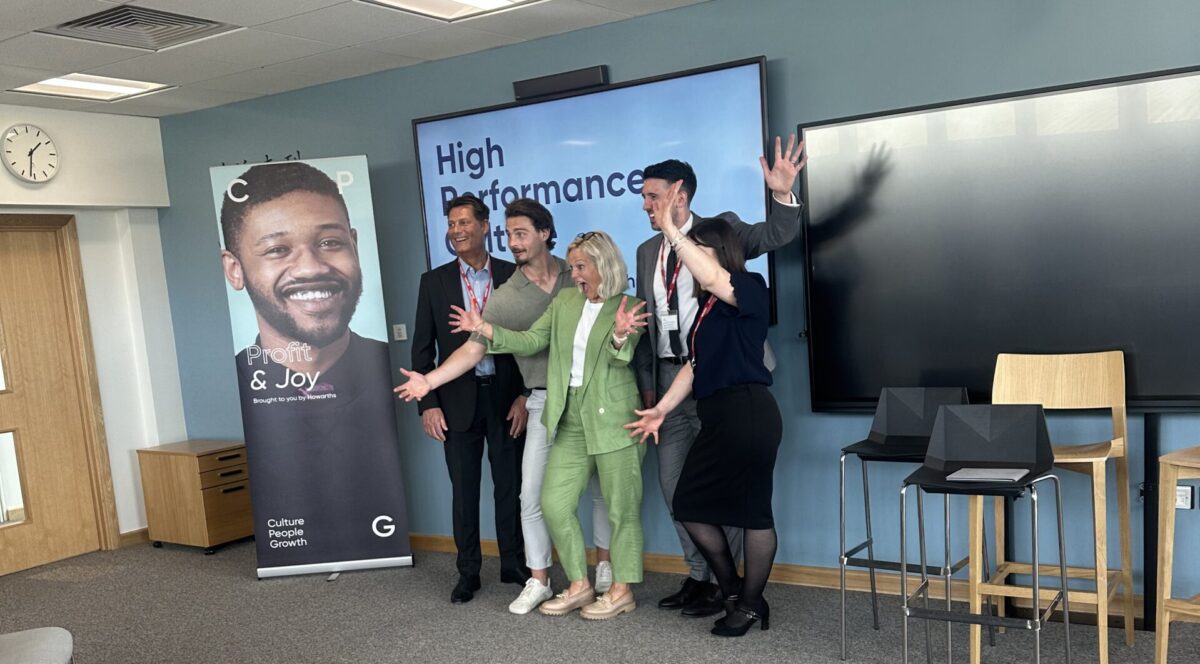
In pursuit of high-performance with heart, match-culture, people and growth
What a beautiful morning it was, heading to our latest Culture. People. Growth. (CPG) event, held at Bettys & Taylors, Harrogate: a ‘proper brew’ was waiting for us all on arrival.
Chaired by our CEO, Gavin Howarth, we welcomed Jo Cowling, People Director Taylors of Harrogate; Matthew Briggs, Chief Executive Officer Edenred; Charlotte Geesin, Chief Legal Officer Howarths; and Stevie Ward, Ex-Leeds Rhinos Captain to the panel.
The focus for this session was: ‘High Performance Culture – 2025 and Beyond’. As you would expect, the discussion flowed with opinions, experiences and hopes for the future all shared.
Here we provide some highlights from the session.
Defining High Performance
Never one to dodge the difficult questions, Gavin started by asking the panel what high performance meant to them.
Matthew said: “For me, it’s an enabler to results. It comes in different shapes and sizes depending on what the business does and its purpose.
“Defining the results and purpose of an organisation first means that you can develop the culture that you need to deliver results, which in some instances are non-negotiable.”
Jo said: “We have six values at Bettys & Taylors including prosperity, which is purposefully not called profit. While we remain committed to results, for us it is also about engagement of people. It’s investment in the local community and those that we are involved with around the world.
“The approach is less corporate and so we have to work out how we get the commitment we need from people while providing them with the opportunity to thrive and grow.”
The role of values in an organisation and whether they matter
With lots of contribution from the panel, it was clear that there is a distinction between what is said and what is done.
Stevie said: “There are a few versions of using values in sport: values on the wall and then what that means, both to individuals and the team. Sometimes, when you don’t add clarity, it confuses more than it makes clear.
“With values, it is essential you address their meaning as they become your compass when you are feeling lost in the woods. If you don’t know what the values mean, you’re already lost.
“I have been a performance addict. With sport you put your body and life on the line for your teammates and that needs to mean something to you. You have to have some skin in the game and to know what you’re standing for.”
Charlotte added: “Taking one step back, for me high performance culture is a nebulous thing. If you split it out, a culture is based on a set of values that are embedded within a team and business allowing them to achieve success for growth and also for people.”
Embracing fear
Rather than being considered entirely negative, fear was instead positioned as opportunity.
Stevie said: “Fear is concurrent and runs alongside everything we do. Although very different, when you look at private equity business and sport, in both instances you are working with fear. The fear that if this job doesn’t get done, we won’t be here long.
“There is a clear notion that fear can be helpful. It nudges you to a place where you have to perform. We have to get some work done and execute. That uncertainty of performing is enough.”
Matthew said: “It’s about consequences. Every action creates a reaction. If I do something, something will happen – if it’s good then great, if it’s not then something still happens.
“In some instances, it’s about encouraging people to create a culture that is bold, knowing that there are recriminations. Ultimately, if repeat failure continues to happen, and nothing is changing, something needs to happen. Something has to change.”
Managing a multi-generational workforce
A hot topic and certainly relevant to the audience – is it possible to have a high-performance culture with a multi-generational workforce?
Jo said: “Here at Bettys & Taylors we look five, ten and twenty years into the future. It’s the most forward-thinking business I’ve ever worked with. There are two more years before more businesses will have five generations to manage.
“What I find interesting is there is a fine line between stereotyping and finding common characteristics between people. Work life balance and personal growth are two things that everyone wants at some level.”
Charlotte added: “In order to create a high-performance culture, one of the best things businesses can do is embrace the concept of mentorship. Knowledge is no longer top down. Because of the generational divide, rather than being a waterfall, we now have a canal in terms of the knowledge we can share.
“If we want to understand something, we need to ask the right people for the right answers, not necessarily those that have been with a business the longest.”
The challenges of a modern workforce
Sharing an example from former Manchester United Manager, Erik ten Hag, who was quoted as saying that modern players struggle to deal with criticism, it was put to the panel to discuss if this is reflected in business.
Stevie said: “I sit in with teams and coaches, and they are terrified of losing. They want things to go right, and they want to win. The first thing they will say is that modern players don’t care like players used to. The challenge then is how you get them to care.
“An obvious truth is that you need performance or everything falls down. But the highest level of performance involves a fear. The fear of performance, of pressure of injury and of not fitting in. There needs to be an allowance for that, an emotional intelligence that is applied.
“It is difficult to be fully who you are; to express yourself. It’s difficult to have the persona of someone having it all together. Expressing any doubt openly could lead to you getting shot down or shamed for mistakes. Vulnerability is going back into the wound. It’s about looking for impression rather than expression.”
Matthew said: “It is a reality of the modern workplace that there are differences; different shapes, sizes and backgrounds. There is nothing that will change it. The question is how you make everyone feel valued and appreciated. That is an important part of creating a healthy workplace.
“Working smart is about strategy, finance, KPIs. Developing a healthy workplace is low politics, high morale, clarity and low attrition. We all know the strategy and how to set targets, but low politics is difficult.
“The thing that changes this is to build trust. In practice, if you pretend you are the smartest person in the room, you’re in the wrong room. The foundations are trust. If you don’t trust each other, you are on a hiding to nothing.”
Addressing a ‘them and us’ culture
Acknowledging this is a challenge that has been around for many years, the panel discussed ways that they approach a ‘them and us’ culture in the workplace, embracing inclusivity and making everyone feel valued, whatever their role.
Jo said: “We have some guiding principles at Bettys & Taylors. For example, everyone comes through the same door and there is only one café that we all use. We have no reserve parking for anyone. For us, it’s about the subtle things about how you build the physical environment to bring people together, removing the ‘them and us’ from our culture.”
Matthew said: “I once removed the reserved parking. The car park was labelled and so I got rid of the allocated spaces. It didn’t go down well.”
Managing the managers
Making reference to Gallup’s Global State of the Workplace Report 2025, which reportedly chronicles a year of declining engagement, deteriorating wellbeing, and growing disconnection, the panel were asked how stressed-out management could be contributing to this.
Jo said: “This topic should be a priority for all of leadership and all of management, it’s not just for HR to sort out. We can put in all the training, but if that is then not emulated and people don’t know what a great manager looks like then it’s just us rolling out more stuff.
“The role of management is tricky. One of the hardest things is to step out of a team and become a leader that will be respected, while accepting that things will be different and will change.”
Matthew concludes: “Lots of companies talk about people being business assets but it’s actually the relationships that you have with people that are your strongest attribute in the workplace.
“You can have someone that is good at sales but if they don’t get along with the people around them it’s toxic. It’s relationships that are fit for purpose and that achieve the outcomes that we all want.”
Final thoughts
What an event!
Tough topics handled with professionalism, knowledge, lived experience and humour. The perfect blend.
The feedback was overwhelmingly positive and as ever, we would like to show our appreciation for those that took the time to join us. Thanks also to the panellists, who were simply fantastic.
If you would like to attend the next invite-only CPG session, please register your interest here: CPG Events – Howarths HR
Register your interest and join the waiting list for our next CPG event on June 18th. Details TBC.


